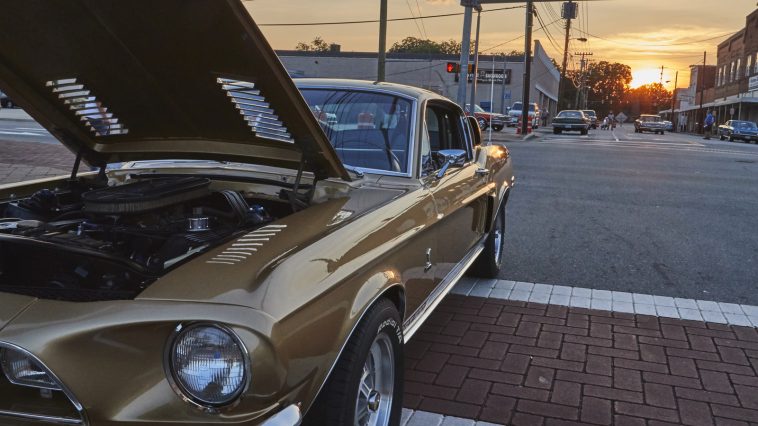Gary W. Carter/Getty Images
The Ford Mustang holds an unimpeachable place in the pantheon of automotive history, taking many forms through its seven generations. As one of the most popular and iconic vehicles of all time, it represents not only a bygone era of American muscle but the height of what modern technology can accomplish as a sports car.
Advertisement
A cultural icon, it has transcended the boundaries of the car world. Its presence is felt not just in gearhead circles, but also in countless movies, television shows, race tracks, and garages across America. Its popularity has turned it into a pop culture sensation, wrapped up in Americana and adored by fans around the world.
The Mustang has been around for over six decades, succeeding where so many of its competitors failed. The only continuously-produced holdover from the original era of American muscle, the Mustang evolved into a tribute to itself, inspiring individuals to fall in love with it all over again year after year.
Not every Mustang in the bunch is a home run (we ranked every Ford Mustang generation from best to worst), but since the original pony car hit the streets in 1965 up to the modern sports cars, Ford has poured endless amounts of love and dedication into its flagship performance vehicle. And that love has been returned in kind by those who fell in love with the pony car.
Advertisement
Whether you are an old Mustang salt or a new fan of the franchise, check out our list of 10 must-know facts for every Ford enthusiast.
The Mustang was the original pony car
Gestalt Imagery/Shutterstock
The 1949 Oldsmobile Rocket 88, believed by some car experts to be the first muscle car ever made, was hardly the first vehicle to use a V8. But the relatively powerful car marked a sea change in marketing. Autobuilders began to advertise performance statistics in addition to comfort features.
Advertisement
The new formula eventually gained a following among car builders. The conventionally accepted first muscle car was the 1964 Pontiac GTO. Ford rewrote the book by taking everything that made a muscle car cool, namely a powerful V8 engine and rear-wheel drive, and putting it in a light and affordable package.
Dubbing the new lightweight V8, the Mustang inadvertently coined a new vehicle genre. Gearheads still discuss what constitutes a muscle car, but the accepted definition centers around a mid-sized vehicle with outsized V8 power.
The Mustang was different. Lightweight and relatively inexpensive, it was speed for the young masses. Editor of Car Life Dennis Shattuck inadvertently stepped into automotive history when he referred to the new formula as a “pony car.”
Advertisement
Henceforth, lightweight muscle would be referred to as pony cars. The Chevrolet Camaro, Pontiac Firebird, Dodge Challenger, and Plymouth Barracuda (itself a co-founder of the category, released months before the original Mustang) all fell under this category.
Shattuck could have called it the stallion, thoroughbred, or the four-legged transportation herbivore, but he went with pony, and the rest is history.
There are V10 Mustangs out there – but you won’t get one
Wirestock/Getty Images
The muscle and pony era is nearly synonymous with V8 power, but Ford once toyed with stuffing a V10 under the hood. During the 1990s, Ford didn’t have a Corvette-beater in its arsenal, and the fan-favorite supercar, Dodge Viper, was the byword for stupid amounts of American power.
Advertisement
The Mustang, while significantly cheaper, couldn’t keep up. A team of engineers decided to do something about it. Jim O’Neill and Greg Coleman of the Powertrain Research & Advanced Engines group started casting for something special to install in the Mustang.They quickly discounted the 6.8-liter V10 Ford had available for its trucks, as it was too tall for the engine compartment, so they created their own.
The project wasn’t exactly sanctioned. “There was less oversight then,” Jim O’Neill explained. With help from some fellow engineers, O’Neill and Coleman took a 4.6-liter V8 and added a cylinder to each side. The resulting 5.8-liter V10 reportedly produced 450 horsepower under the hood of a 1999 GT that had been slated for the crusher.
Advertisement
O’Neill began promoting the new configuration within Ford, but the economic downturn of the mid-aughts killed it as a potential production car, depriving us all of a new standard for Mustang.
The Americans weren’t the only ones interested in a V10 Mustang. Ford Racing Australia took it to the next level by installing a supercharged 7.0-liter V10 in a 2000 model.
The Mustang almost went front-wheel drive
ArtemGromov/Shutterstock
While the debate still burns, most agree that the two requirements of a muscle or pony car are rear-wheel drive and a V8 engine. Take that away from a vehicle, and it immediately departs the muscle car world. Ford almost made this exact mistake when pondering the future of the fourth-generation Mustang.
Advertisement
During the 1980s, the Fox-body Mustang was popular but a shadow of its former self. Gas crises and environmental regulations gutted the pony car’s once proud tradition of no-replacement-for-displacement ethos.
Front-wheel-drive grew popular, and Japanese imports like the Acura Integra and Toyota Celica were eating up the market. Ford had a relationship with Mazda, who had a coupe that almost replaced the Mustang. The front wheel drive architecture couldn’t handle a V8, so Mustang lovers would have to settle for a V6.
Reaction to the plan was immediate and severe. When news of the possible redesign reached the public, a massive letter-writing campaign ensued. Coupled with disgust from the media, the Ford executives (not all of whom were keen on the idea) thankfully shut down the endeavor.
Advertisement
If you’re wondering what a front-wheel-drive Ford Mustang might be like, look no further than every Ford Probe model. It is what came from thinking of using a Mazda vehicle to replace America’s most iconic car.
A mid-engine Mustang almost happened
Unsurprisingly, some of the best sports cars in the world use midship-mounted engines. From Porsche’s slavish devotion to the configuration to the C8 Corvette’s adoption in 2020, midship vehicles have more than proven their mettle. Midships offer superior balance, spreading the weight of the heaviest part of a vehicle, the engine, over all four wheels for improved traction and handling.
Advertisement
What might be surprising is that Ford considered and even built a midship Mustang back in the ’60s — and not just any Mustang — the legendary Mustang Boss 429. The Boss 429 was a high-performance variant of the Ford Mustang, featuring a massive big block engine under the hood. However, engineers were dissatisfied with all that weight hanging over the front end.
Ford flipped the iron-blocked engine around and repurposed the former engine compartment to house cooling and electrical equipment, not unlike the supercars of today.
Known as the LID Mustang, it seemed like the best of all worlds — a European-style engine location combined with raw American power. So why didn’t Ford go midship with the Mustang? The shift in weight didn’t provide any significant performance enhancements. Retooling to mass produce the midship Mustang would be an expensive and futile endeavor.
Advertisement
The Mustang LID disappeared from history. Some claim it went to the crusher, others that it sat in a wrecking yard for a few years before disappearing. The mystery of its fate adds to the intrigue. It’s nice to imagine the midship monster is still out there, huddling in the shadows of some garage, awaiting a glorious return.
The Mustang wasn’t named after a horse
That’s a tough one to swallow. The proof is in the pudding on this one — the emblem is a galloping horse. It coined the term “pony car.” It’s called the Mustang — what else could it be?
Two decades before Ford introduced the Mustang, the Second World War raged in Europe. Aviation advanced considerably in a few short years, and an advanced fighter plane called the P-51 emerged as a dominant force in the skies over Europe in the late war.
Advertisement
One of the Mustang team members, John Najjar, was preoccupied with the elegance, power, and beauty of the P-51. As a co-designer of the original Mustang prototype, he also had a chance to offer a name for Ford’s revolutionary new car. He suggested the P-51’s nickname, the Mustang.
Though the Mustang went forth with its famous galloping horse emblem, the name’s roots are remembered by Mustang enthusiasts. Celebrated Mustang modifier Jack Roush, who owns an actual P-51 Mustang fighter plane, paid homage to the namesake with a customized 727-horsepower 2017 Ford Mustang painted in the combat aircraft’s silver-and-black livery.
The first Cobra was the worst Mustang
Pokemonprime/Wikimedia Commons/CC BY 4.0
The cobra name has been associated with the Ford Mustang since its first generation. During the 1960s, the Shelby Cobra was on its way to becoming an automotive immortal. Caroll Shelby used Ford engines in his AC Cars-based racer.
Advertisement
He also built the Shelby Mustang GT350. As his relationship with Ford grew, the automaker began incorporating the Cobra name into more products. The 428 Cobra Jet V8 engine is one of the most desired of the muscle era, gaining fame in the original “Gone in 60 Seconds” movie.
But it wasn’t until the muscle downturn of the 1970s that Ford committed to building an official Ford Mustang Cobra. Unfortunately, the idea came about during the tenure of the worst generation of Mustang. By the time the Mustang II rolled around for the 1974 model year, the pony was sick. Underpowered and lacking the iconic design of the first gen, it was an important, albeit underwhelming chapter in Mustang history.
Advertisement
Ford’s first Mustang Cobra arrived during the Mustang II’s four-year production run. The 1976 Cobra II, as it was known, was a race-oriented model replete with racing stripes, a hood scoop, a rear spoiler, and oh-so-70s window louvers.
The King Cobra special edition arrived in 1978 as a cosmetics upgrade with a 302 ci V8, disc brakes, custom pinstriping, and snake decals. Though the Mustang II has not aged as well as other generations, it was popular in its day, and the King Cobra serves as an interesting footnote in its history.
There is no 1964 ½ Mustang
An oft-quoted piece of Mustang lore is that the first model was a 1964 ½ model year. In the technical sense, that is both true and untrue. Ford debuted the original Mustang at the New York World Fair in April 1964. Manufacturers typically unveiled new models in autumn, but the Mustang was something of a rush project, and it wasn’t ready.
Advertisement
The Mustang’s late debut is only half of the story. Aside from the fact that it showed up late, Ford continued to tweak its newest family member throughout the production year. Enthusiasts split the original Mustang between models produced before and after August 1964.
Ford projected to sell 100,000 Mustangs in its first year, but plans changed when 22,000 went out the door on the first day. Sensing that the inaugural Mustang was about to run away with the market (Ford eventually sold 681,000), Ford rethought some things. Initially offered as a coupe and convertible, the fastback body option appeared in late-1965.
Despite all this, Ford doesn’t officially recognize a 1964 ½ Mustang, formally calling the first year a 1965. Furthermore, no official registering offices recognize half-years in vehicle nomenclature. The 1964 ½ Mustang mainly refers to early-production 1965 models, though Ford did start recognizing its April 17, 1964, appearance at the World Fair as its official anniversary date.
Advertisement
It is the most produced sports car in history
Tramino/Getty Images
The Mustang’s profile has changed significantly over the years. Initially introduced in 1964 as a lightweight, affordable, and stylish car, it was a hit among consumers and quickly became a symbol of American muscle cars. By its 60th anniversary, it has morphed into what can only be called a 2+2 sports car. Whether or not you regard pony cars as a subset of sports cars somewhat tweaks the conversation, but the bottom line is Ford has sold more Mustangs than any other sports car producer.
Advertisement
If Ford’s initial mission was to create a high-speed car that the masses could afford, it has not just succeeded but excelled. Since its inception in 1964, the Mustang has sold over 10 million units, with a million flying off the shelves in the first 24 months alone. Its peak year was 1966, when Ford rolled a staggering 559,641 models into garages across America.
While Ford is the force behind the Mustang, its sub-brands have also carved a niche for themselves. The aftermarket builders, such as Roush and Saleen, elevate stock Mustangs to new heights. The special edition factory builds like the Shelby and GT series, along with the more affordable base packages, ensure that there’s something for everyone, regardless of their performance and price preferences.
Advertisement
Right-hand drive Mustangs showed up very late
Beanykin/Shutterstock
Despite the incredible proliferation of Mustangs, factory-built right-hand drive versions didn’t show up until 2015. Most driving nations drive on the right side of the road with steering wheels and controls on the left side of the car, but it’s closer than you might think. While 174 nations and territories drive this way, 78 use the left side of the road.
Advertisement
Some significant markets, including Japan, Australia, the U.K., South Africa, and India, drive on the left. Despite this, Ford did not produce right-hand-drive Ford Mustangs until the sixth generation debuted in 2015.
Aussie engineering firm Tickford Vehicle Engineering produced some right-hand drive (confusingly, the name for cars that drive on the left side of the road) Cobras and convertibles between 2001 and 2003. Tickford had Ford’s blessing, making them quasi-official left Mustangs, but Ford held out for a long time before doing it straight from the factory.
It seems to have been the right decision. As one of the world’s most popular cars, tons of would-be Mustang purchasers were waiting for one. Before release, 4,000 buyers joined a 12-month pre-sold waiting list in Australia.
Advertisement
It’s been a few years since Mustang went lefty, so if you happen to be jonesing for a Mustang in a left-hand-drive country, that waiting list may have died down a bit.
The seventh-generation Mustang has the highest average used price
John Keeble/Getty Images
This one may come as a surprise. Classics like the Mustang are often most valuable in their inaugural form, the firebreathing V8s with classical lines of yesteryear. It is a testament to Mustang’s desirability and performance that the latest iteration seems to have the most value.
Advertisement
At least some of that value is attributed to the seventh generation being essentially brand new. It debuted in 2024 with some genuinely high-performance options like the Dark Horse, one of the most powerful Mustangs ever made.
Classic.com, which tracks market values, reports that the seventh-gen currently demands an average used price of $74,440. The first generation’s average of $55,671 makes it the runner-up in the average value game. A price like that precludes most from picking one up as a daily driver, but perhaps the actual story is told with the top sale numbers: the highest reported price of a Mustang sits at $605,000 for a first gen.
The second-generation Mustang II is the most expensive used car at an average cost of $19,132, followed by the fourth-generation SN-95 at $22,528, the third-generation Fox body at $25,101, the fifth-generation retro revamp at $31,294, and the 2015 to 2023 sixth-generation at $44,918.
Advertisement





GIPHY App Key not set. Please check settings